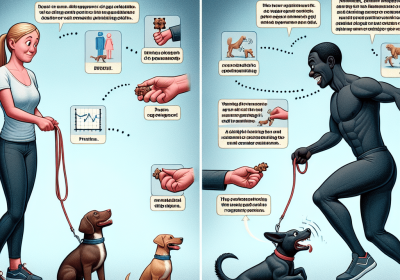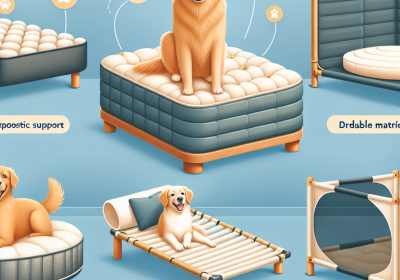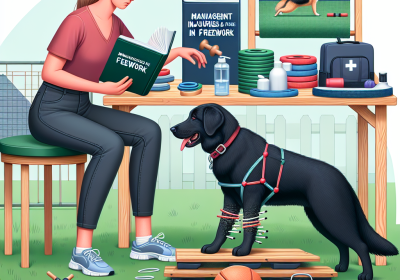Canine Freework as a Form of Exercise for Dogs
Table of Contents
- Benefits Of Canine Freework For Your Dog’s Physical Health
- How To Get Started With Canine Freework: A Beginner’s Guide
- Enhancing Your Dog’s Mental Well-being Through Canine Freework
Canine Freework is an innovative and enriching form of exercise designed to engage a dog’s natural instincts and promote physical and mental well-being. Unlike traditional structured activities, Canine Freework emphasizes a dog’s autonomy, allowing them to explore their environment at their own pace and make independent choices. This approach not only provides physical exercise but also stimulates cognitive functions, reduces stress, and enhances the bond between dogs and their owners. By incorporating elements such as scent work, obstacle navigation, and problem-solving tasks, Canine Freework offers a holistic and enjoyable way for dogs to stay active and healthy.
Benefits Of Canine Freework For Your Dog’s Physical Health
Canine freework, an innovative approach to dog exercise, offers a multitude of benefits for your dog’s physical health. This method, which emphasizes natural movement and exploration, allows dogs to engage in activities that promote overall well-being. By incorporating canine freework into your dog’s routine, you can enhance their physical fitness, improve their coordination, and support their musculoskeletal health.
One of the primary advantages of canine freework is its ability to provide a comprehensive workout for your dog. Unlike traditional forms of exercise, such as walking or running, freework encourages a variety of movements that engage different muscle groups. This holistic approach ensures that your dog receives a balanced workout, which is essential for maintaining optimal physical health. For instance, activities like climbing, jumping, and crawling can help strengthen your dog’s core muscles, improve their balance, and enhance their agility.
Moreover, canine freework can be particularly beneficial for dogs with specific physical needs or limitations. For example, older dogs or those recovering from injuries may find traditional exercise routines too strenuous. Freework allows these dogs to move at their own pace and choose activities that are comfortable for them, thereby reducing the risk of overexertion or injury. Additionally, the low-impact nature of many freework activities can help alleviate joint stress, making it an ideal option for dogs with arthritis or other joint-related issues.
In addition to promoting muscle strength and joint health, canine freework also supports cardiovascular fitness. Engaging in varied and dynamic activities can elevate your dog’s heart rate, improving circulation and overall cardiovascular function. This is particularly important for maintaining a healthy weight and preventing obesity-related conditions, such as diabetes and heart disease. By incorporating freework into your dog’s exercise regimen, you can help ensure they remain fit and healthy throughout their life.
Furthermore, canine freework can enhance your dog’s proprioception, which is their ability to sense the position and movement of their body. This is achieved through activities that require precise movements and coordination, such as navigating obstacles or balancing on uneven surfaces. Improved proprioception can lead to better coordination and stability, reducing the likelihood of falls and injuries. This is especially beneficial for working dogs or those involved in canine sports, where agility and precision are crucial.
Another significant benefit of canine freework is its positive impact on mental health, which is closely linked to physical well-being. Engaging in freework activities stimulates your dog’s mind, providing mental enrichment and reducing stress. This can lead to a more relaxed and contented dog, which in turn can have a positive effect on their physical health. Stress reduction is known to lower the risk of various health issues, including gastrointestinal problems and weakened immune function.
In conclusion, canine freework offers a versatile and effective way to enhance your dog’s physical health. By promoting muscle strength, joint health, cardiovascular fitness, and proprioception, this approach provides a comprehensive workout that caters to your dog’s individual needs. Additionally, the mental stimulation and stress reduction associated with freework contribute to overall well-being, making it a valuable addition to any dog’s exercise routine. By embracing canine freework, you can help ensure your dog leads a healthy, active, and fulfilling life.
How To Get Started With Canine Freework: A Beginner’s Guide

Canine Freework is an innovative and engaging form of exercise that offers numerous benefits for dogs of all ages and breeds. This activity focuses on allowing dogs to explore their environment freely, using their natural instincts and senses to navigate various obstacles and challenges. As a beginner, getting started with Canine Freework may seem daunting, but with the right approach, it can be a rewarding experience for both you and your canine companion.
To begin with, it is essential to understand the fundamental principles of Canine Freework. This exercise emphasizes the importance of mental stimulation and physical activity, encouraging dogs to use their innate problem-solving skills. Unlike traditional obedience training, Canine Freework does not require strict commands or structured routines. Instead, it promotes a more relaxed and exploratory approach, allowing dogs to engage with their surroundings at their own pace.
Before embarking on your Canine Freework journey, it is crucial to ensure that your dog is in good health. A visit to the veterinarian for a thorough check-up will help identify any underlying health issues that may affect your dog’s ability to participate in this activity. Additionally, it is important to consider your dog’s age, breed, and individual temperament when planning your Freework sessions. Puppies and senior dogs may require shorter, less strenuous activities, while more energetic breeds may benefit from more challenging tasks.
Once you have assessed your dog’s health and capabilities, the next step is to create a safe and stimulating environment for Canine Freework. This can be done both indoors and outdoors, depending on the available space and weather conditions. Indoors, you can use household items such as cushions, boxes, and furniture to create an obstacle course. Outdoors, natural elements like trees, bushes, and uneven terrain can provide a diverse and enriching environment for your dog to explore.
When setting up your Canine Freework area, it is important to prioritize safety. Ensure that there are no sharp objects or hazardous materials that could harm your dog. Additionally, supervise your dog closely during the initial sessions to prevent any accidents or injuries. As your dog becomes more familiar with the activity, you can gradually introduce more complex obstacles and challenges to keep them engaged and motivated.
To encourage your dog to participate in Canine Freework, use positive reinforcement techniques such as treats, praise, and toys. This will help build your dog’s confidence and enthusiasm for the activity. It is also important to be patient and allow your dog to explore at their own pace. Avoid forcing your dog to complete tasks or navigate obstacles, as this can lead to stress and anxiety.
As you and your dog become more experienced with Canine Freework, you can experiment with different environments and challenges to keep the activity fresh and exciting. For example, you can take your dog to new locations such as parks, beaches, or hiking trails, where they can encounter a variety of sensory experiences. Additionally, you can incorporate scent work, agility exercises, and problem-solving tasks to further enhance your dog’s mental and physical stimulation.
In conclusion, Canine Freework is a versatile and enjoyable form of exercise that can benefit dogs in numerous ways. By understanding the principles of this activity, creating a safe and stimulating environment, and using positive reinforcement techniques, you can successfully introduce your dog to Canine Freework. With time and practice, this activity can become a valuable part of your dog’s routine, promoting their overall well-being and strengthening the bond between you and your canine companion.
Enhancing Your Dog’s Mental Well-being Through Canine Freework
Canine Freework, an innovative approach to dog exercise, is gaining recognition for its multifaceted benefits, particularly in enhancing a dog’s mental well-being. This method, which emphasizes freedom of movement and choice, allows dogs to engage in natural behaviors, thereby promoting mental stimulation and reducing stress. Unlike traditional forms of exercise that often focus solely on physical exertion, Canine Freework integrates mental challenges, making it a holistic approach to canine health.
One of the primary advantages of Canine Freework is its ability to cater to a dog’s innate curiosity and problem-solving skills. By setting up environments that encourage exploration, dogs are given the opportunity to use their senses in a more dynamic way. For instance, a simple setup might include various textures, scents, and objects that a dog can interact with at its own pace. This not only keeps the dog physically active but also engages its mind, fostering cognitive development and emotional satisfaction.
Moreover, Canine Freework is particularly beneficial for dogs that may not thrive in more structured or high-energy activities. Older dogs, those recovering from injuries, or dogs with anxiety issues can find traditional exercise regimens overwhelming or even detrimental. In contrast, Canine Freework allows these dogs to move and explore in a manner that is both gentle and stimulating. This adaptability makes it an inclusive form of exercise, suitable for a wide range of canine personalities and physical conditions.
Transitioning to the practical aspects, implementing Canine Freework does not require extensive resources or specialized equipment. Pet owners can easily create engaging environments using everyday household items. For example, placing a variety of objects such as cardboard boxes, towels, and toys in an open space can provide ample opportunities for exploration. The key is to ensure that the environment is safe and that the dog has the freedom to choose how it interacts with each element. This autonomy is crucial, as it empowers the dog to make decisions, thereby boosting its confidence and sense of control.
Furthermore, Canine Freework can be seamlessly integrated into a dog’s daily routine. Short, frequent sessions can be more effective than longer, sporadic ones, as they keep the dog consistently engaged without causing fatigue. Observing the dog’s behavior during these sessions can also provide valuable insights into its preferences and needs, allowing pet owners to tailor future setups accordingly. This ongoing interaction not only strengthens the bond between the dog and its owner but also ensures that the exercise remains enjoyable and beneficial.
In addition to its immediate benefits, Canine Freework can have long-term positive effects on a dog’s overall well-being. Regular mental stimulation has been shown to reduce the risk of cognitive decline in aging dogs, much like how mental exercises benefit human brains. Moreover, the reduction in stress and anxiety levels can lead to improved physical health, as chronic stress is known to have detrimental effects on the body. Thus, Canine Freework serves as a preventive measure, promoting a healthier, happier life for dogs.
In conclusion, Canine Freework represents a paradigm shift in how we approach dog exercise, emphasizing mental well-being alongside physical health. By providing environments that encourage natural behaviors and decision-making, this method offers a comprehensive solution to the diverse needs of dogs. As more pet owners recognize the value of mental stimulation, Canine Freework is poised to become an integral part of canine care, ensuring that our furry companions lead enriched and fulfilling lives.
Read more about Canine Freework
Canine Freework and Physical Exercise
– The Physical Demands of Canine Freework
– Canine Freework as a Form of Exercise for Dogs
– How to Safely Increase Physical Demands in Canine Freework
– Combining Canine Freework with Other Forms of Exercise
– Managing Injuries and Fatigue in Canine Freework






![The Dog Podcast Uncovers Startling Truths About What We Feed Our Dogs [Press Release]](https://narrativenest.com.au/wp-content/uploads/2024/08/canine-nutritious-food-400x280.jpg)


